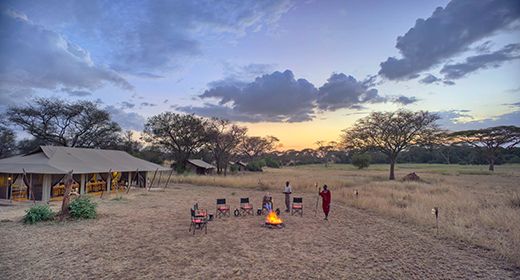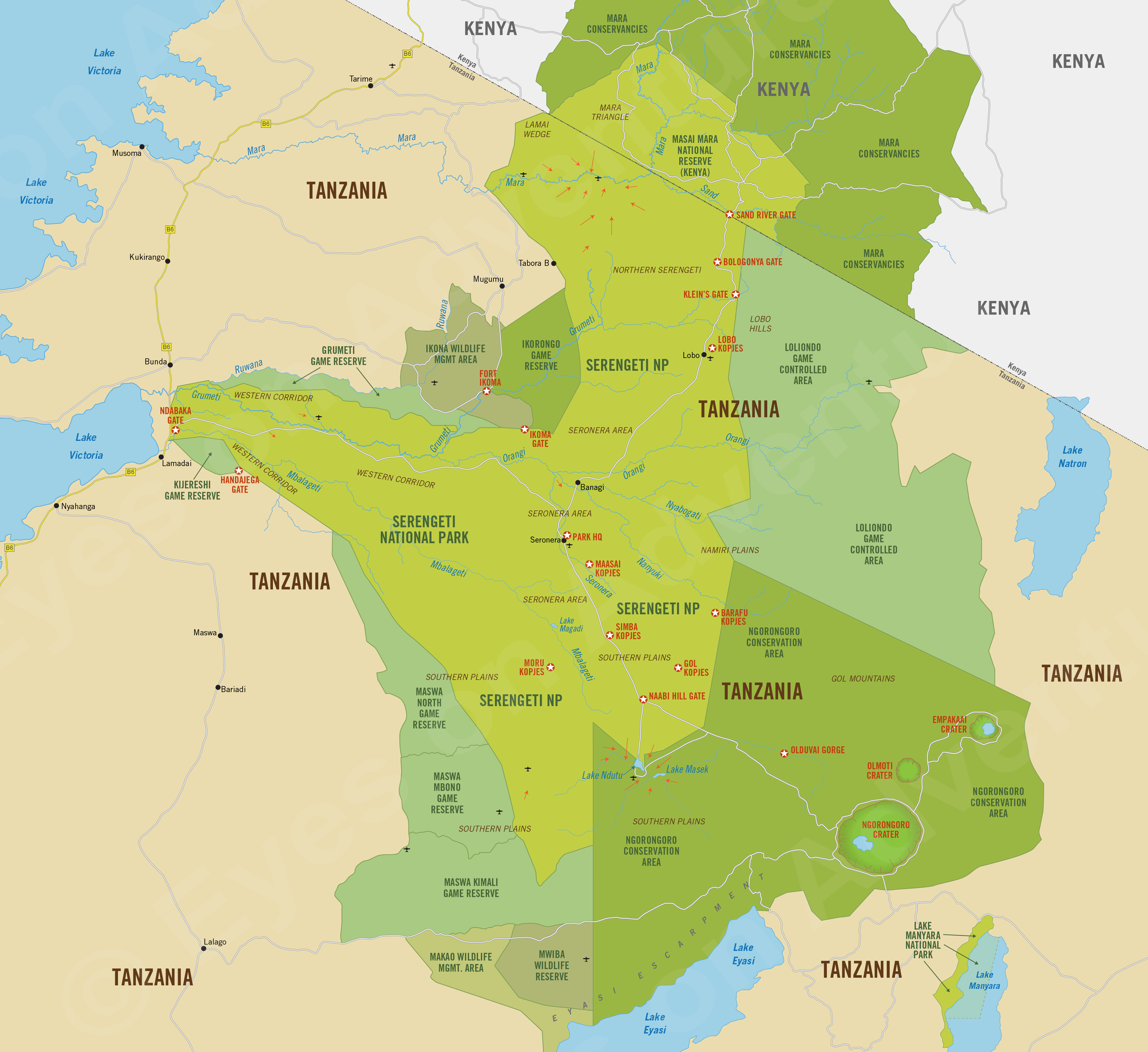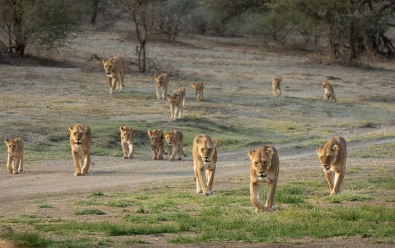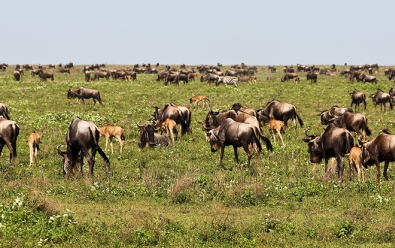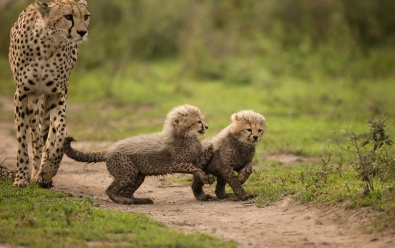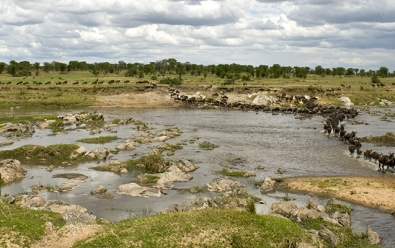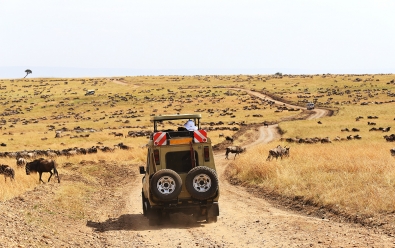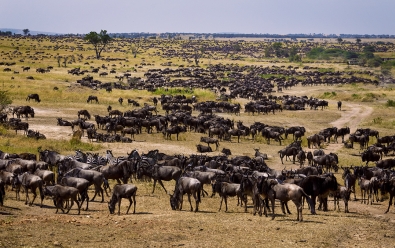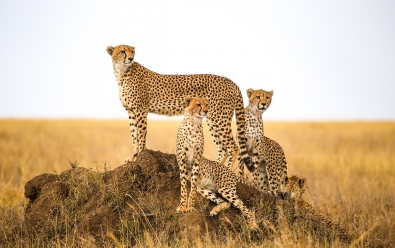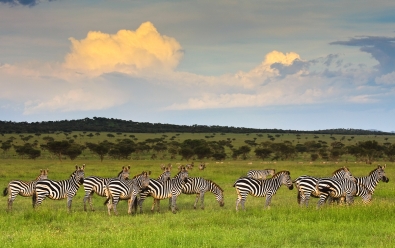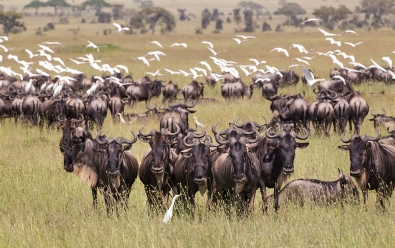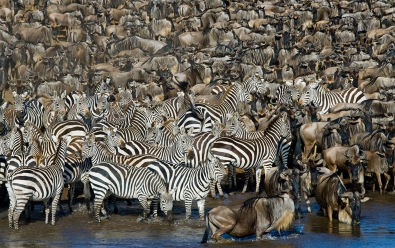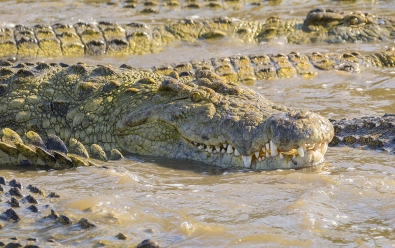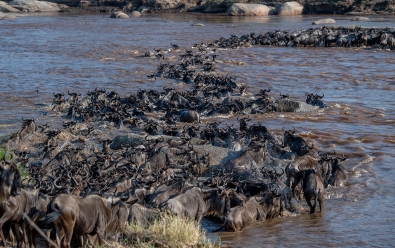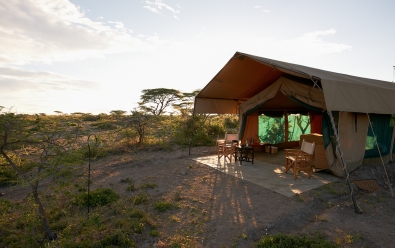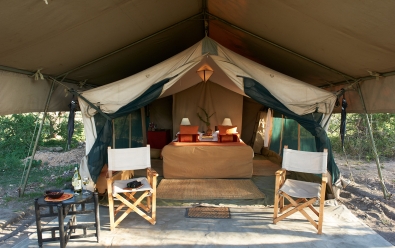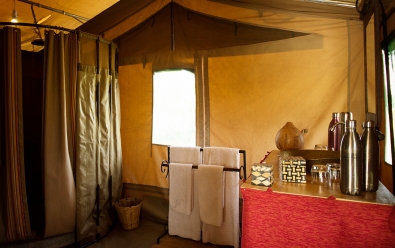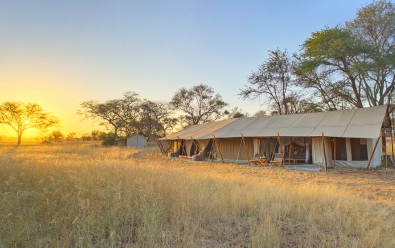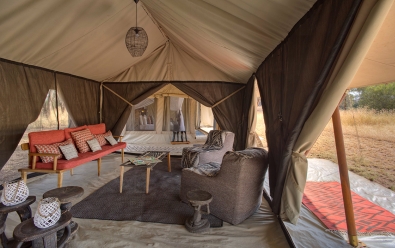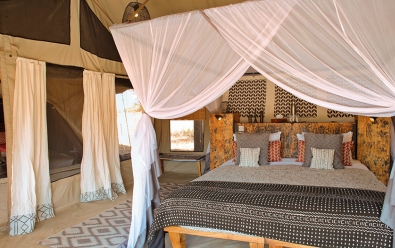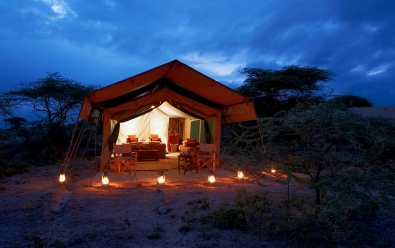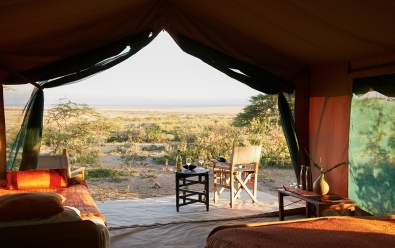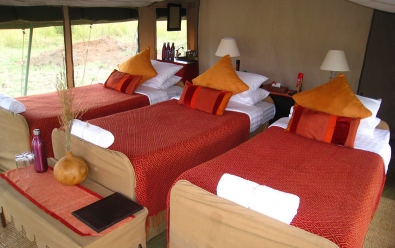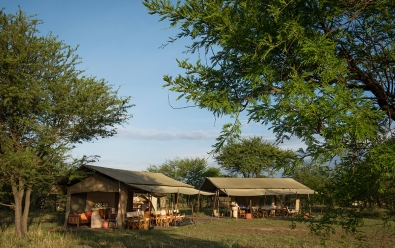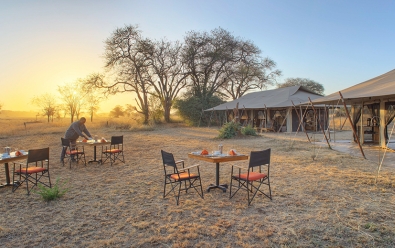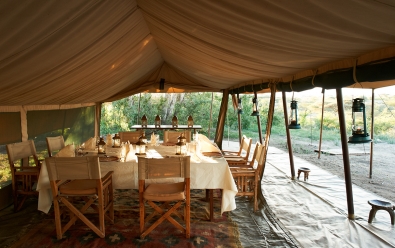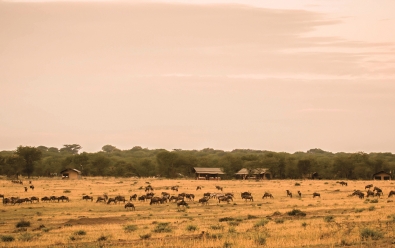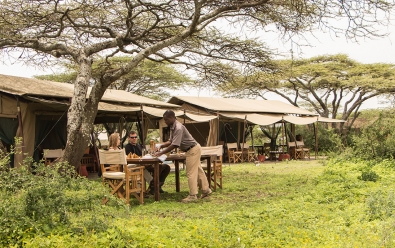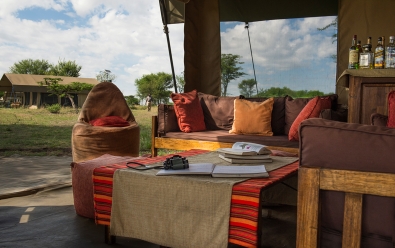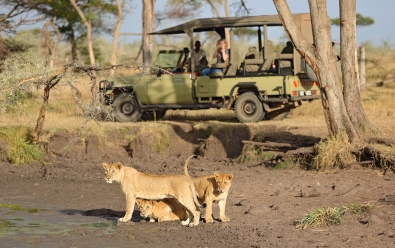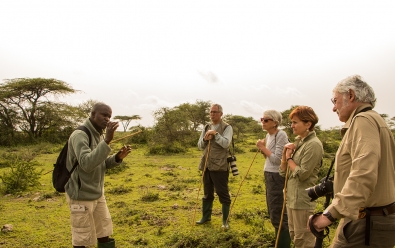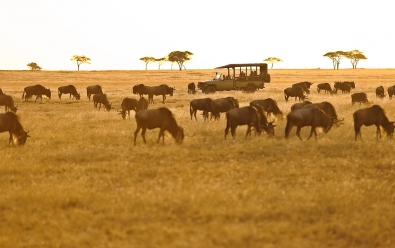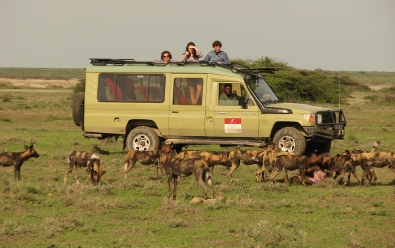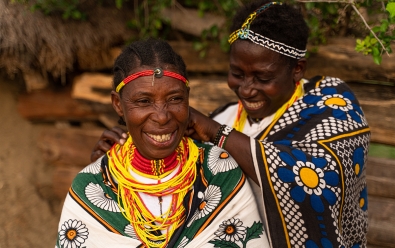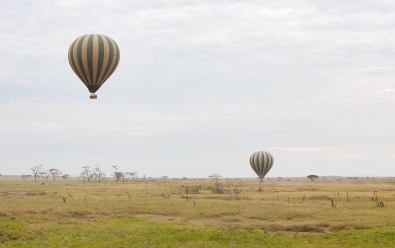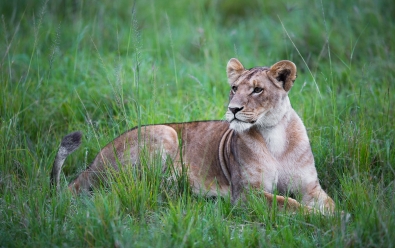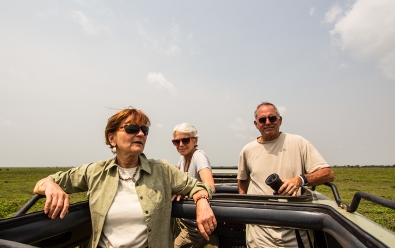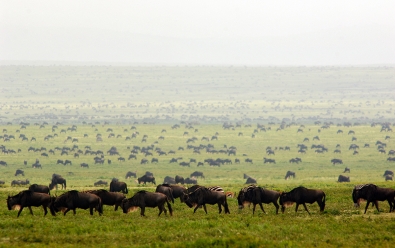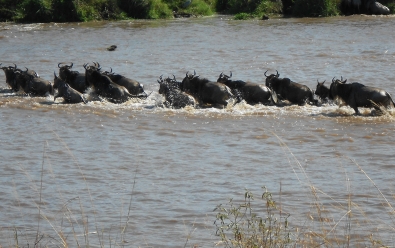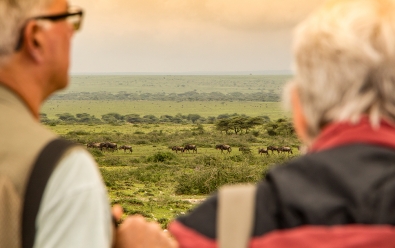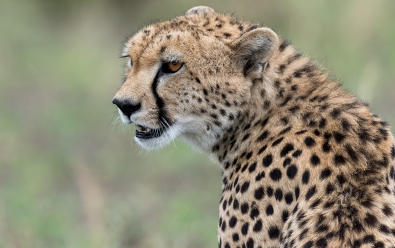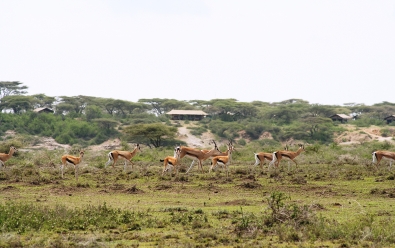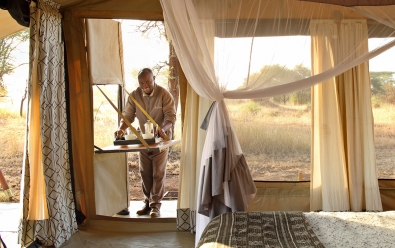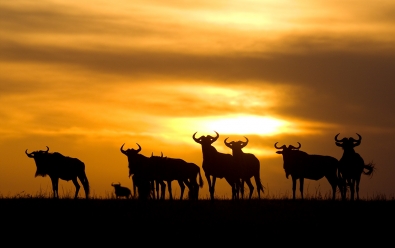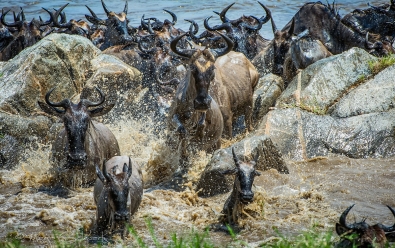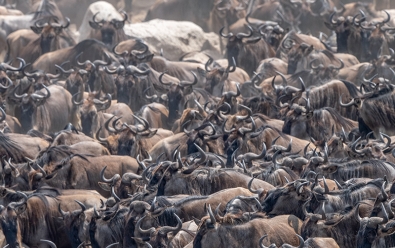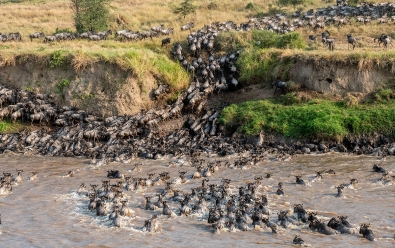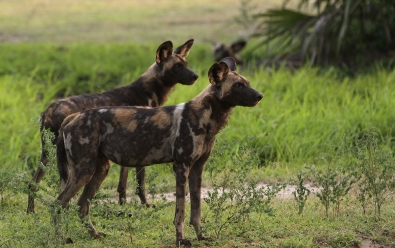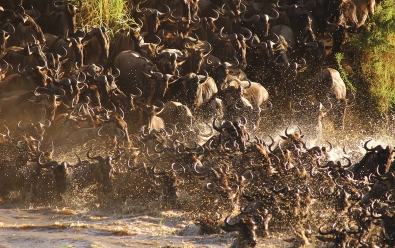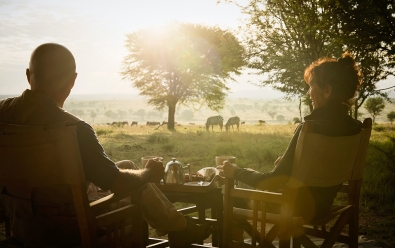Ubuntu Migration Camp
Highlights
- Moves seasonally to be close to the Great Migration
- A classic and authentic mobile camping experience
- Choose from two camp locations in the Serengeti
- Both locations offer excellent wildlife viewing
Location
- Changes Seasonally
- Serengeti National Park
- Northern Tanzania
Ubuntu is a classic, mobile safari camp that changes its location seasonally in order to be close to the great migrating herds of over two million wildebeests and zebras.
The camp changes its location twice per year, positioning seasonally in the far north of the Serengeti from mid-June to mid-November and in the Southern Serengeti from mid-December to mid-March. The camp is taken down completely when it moves between its northern and southern locations.
Guests staying at the camp's northern location will have an opportunity to witness dramatic Mara River crossings, while the camp's southern Serengeti location is timed to coincide with the wildebeest calving season, when over a half-million babies are added to the herds.
Check the Details tab for the exact dates and locations for the camp.
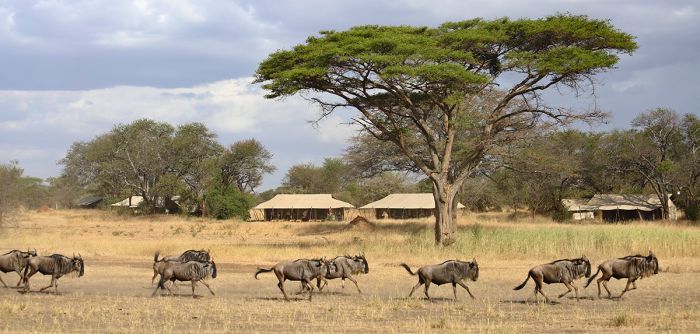
Migrating blue wildebeests running past Ubuntu Migration Camp.
Ubuntu offers 10 classic, Meru-style safari tents, including one extra-large, two-bedroom unit designed for a family with children in the second bedroom. The tents are, as expected basic, but with every comfort possible. The en-suite facilities are not plumbed, but include bucket showers (hot water provided), wash basins, and flush toilets.
The main camp area includes two, open-plan, tented spaces, one used for dining and the other offering a comfortable lounge. Dining is often al fresco and the inviting campfire is a popular place in the evenings.
Activities are focused on twice-daily game drives to see the migration and resident wildlife. Additional activities offered include guided bush walks and cultural visits to a Kuria tribe settlement in the northern location, and hot-air ballooning in the southern locale.
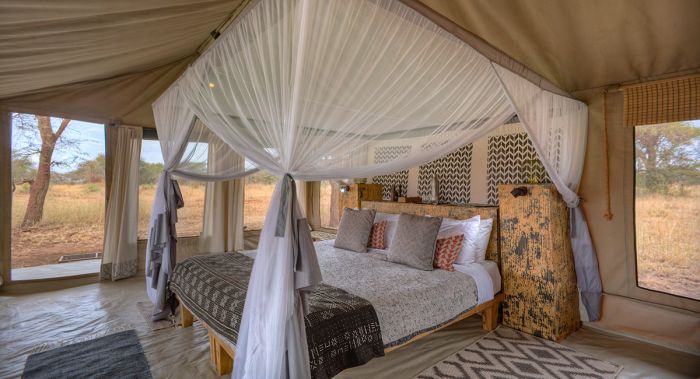
Guest tent interior at Ubuntu Migration Camp.
About the Serengeti
The Greater Serengeti is part of an extensive ecosystem that includes Serengeti National Park, the Ngorongoro Conservation Area, and other reserves, wildlife management areas, and game controlled areas.
The Greater Masai Mara (directly to the north in Kenya) includes the Masai Mara National Reserve, as well as numerous private Mara conservancies. Together, the combined Greater Serengeti-Mara ecosystem, which combines the areas described above, covers roughly 15 000 square miles (39 000 sq kms).
The Serengeti-Mara is home to a very large number and diversity of wild animals and is also the location of the well-known "Great Migration" of over 2 million herbivores (read more below). This is arguably Africa's greatest overall wildlife destination.
Wildlife densities in the Greater Serengeti are some of the highest in Africa, with commonly seen herbivores including blue wildebeest, plains zebra, Thomson's gazelle, topi, Grant's gazelle, hartebeest, giraffe, elephant, buffalo, impala, waterbuck, bushbuck, warthog, and many others. Predators seen often include lion, leopard, spotted hyena, cheetah, serval, and jackal. Hippo and crocodile are found in large numbers in the larger rivers, including the Mara River and the Grumeti River.
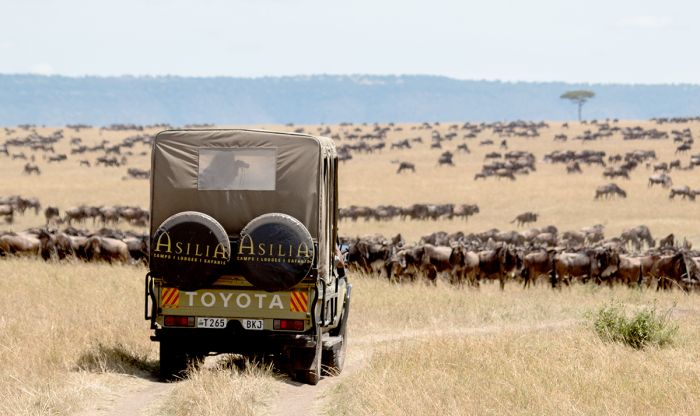
A game drive from Ubuntu Camp with lots of migrating wildebeests.
About the Southern Plains
Ubuntu Migration Camp is situated in the Southern Serengeti Plains from mid-December to mid-March.
Much of the southern half of the park is open, semi-arid grasslands and they form the main base of the park's ecosystem. When the migration arrives to the plains between January and April, the entire landscape is full of an almost unimaginable number of wildebeest, zebras, and gazelles, all grazing on the rich grass that grows here.
The richness of these plains is the result of volcanic ash that was deposited here by long-ago eruptions of the volcanoes in the Ngorongoro Highlands to the east. The ash contains minerals that are important supplements to the nutrition of herbivores, especially lactating females, which is why most of the wildebeests give birth on these plains during January and February.
When the migration moves on to the north, the plains are still home to plentiful year-round wildlife, including lion, cheetah, and large numbers of spotted hyenas, which hunt a wide diversity of prey species, such as topi, red hartebeest, Grant's gazelle, Thomson's gazelle, warthog, and more. The Southern Plains extend past the national park's boundaries into the NCA and Maswa Game Reserves.
About the Northern Serengeti
Ubuntu Migration Camp is situated in the Northern Serengeti from mid-June to mid-November.
The hilly northern sector of Serengeti National Park stretches north from the central Seronera portion of the park all the way to the Mara River and the Kenya border. The northern sector is characterized by Acacia thickets and rolling grasslands and comprises about one-third of the park.
Besides the Mara River, which is the focal point of dramatic river crossings by wildebeests and zebras in from around late July into September, the northern sector also includes part of the Grumeti River and the well-known Lobo region, with its dramatic rock formations known as 'kopjes'.
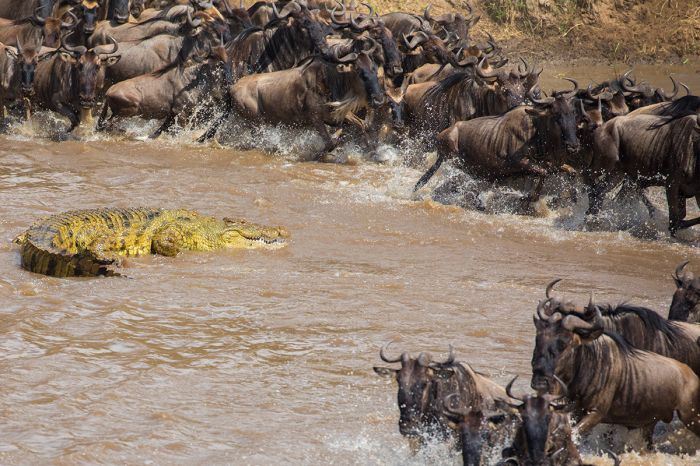
Nile crocodiles pose a serious threat to wildebeests and zebras whenever they cross the Mara River.
Most of the safari camps in the north are situated along or very near to the Mara River, which becomes the focal point of action when the migrating herds of wildebeest and zebra arrives sometime around early August. This area along the Mara River is known as 'Kogatende' and the proliferation of camps along the river is due to the incredible wildlife viewing opportunities here when the herds arrive. The drama unfolds when the herds congregate and eventually cross the Mara River en masse with plenty of huge crocodiles in wait. August is the peak month for river crossings, but Kogatende offers superb wildlife viewing from August thru October.
The Lobo area, which is located in the southern extent of the northern sector and along the eastern border of the national park, is excellent during late September and October, when the wildebeest and zebra migration passes through on its way back south from Kenya, heading towards the southern plains. Lobo Kopjes, a group of huge granite boulders is a favorite hangout for large prides of lions and also draws leopards, spotted hyenas, and even cheetahs.
Excluding the migration period, the overall wildlife viewing in the north is not as spectacular as the more "classic" and open areas further south in Seronera and the Southern Plains, but there is still good resident wildlife in the north. Most of the Serengeti's elephants are found in the north, and there are also good resident numbers of zebra, buffalo, warthog, and gazelle.
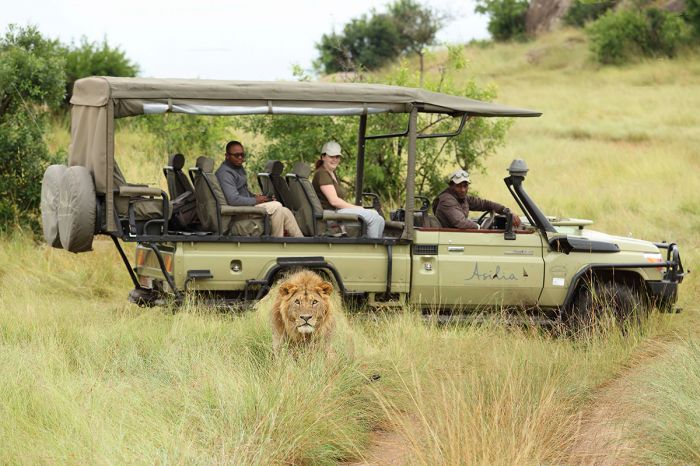
A male lion seen on game drive.
The Great Migration
One of nature's greatest living spectacles is the Great Migration, a term given to describe the year-long, circular, clockwise march of over two million herbivores across the Serengeti and Masai Mara grasslands. The migration animals are made up entirely of two species: the blue wildebeest and the plains zebra (the majority of which are wildebeests).
The migrating herds follow their instincts to seek out fresh grazing and so the migration is ongoing, with the herds ever moving and taking a full year to complete a cycle across the Serengeti and Masai Mara. The animals move not as one herd, but as tens of thousands of animals in multiple herds of various sizes and spread out for many miles as they move.
The wildebeests and zebras take advantage of strongly seasonal conditions, spending the wet season (November through May) on the plains of Tanzania's Serengeti and the dry season in Kenya's Masai Mara. The wildebeests give birth between January and March on the short grass plains in the southern Serengeti.
The timing of the migration is rarely ever the same year-to-year, as local conditions influence grass growth and as such, the location of the bulk of there animals cannot be known precisely. Rains and other unknown conditions seem to direct the timing of the migration, but generally, it is known within several weeks when the animals will be in a general location.
The animals spread out to cover a vast area, but the main bulk of the animals moves south into the northern Serengeti around late-October and continue moving south towards the Serengeti's southern plains, arriving there sometime in January to graze on the rich grass growing on the volcanic soils. It is here on these short-grass plains, between January and early March, when the wildebeests give birth to their young en masse, producing some 500 000 baby wildebeests.
The herds remain on the southern short-grass plains until late March, giving the young animals time to grow and become strong, before heading north and west again. Many of the animals move towards the Serengeti's Western Corridor and Grumeti Reserve and the rest straight north into Central and Northern Serengeti, where they remain during June and into July. The herds move back into Kenya starting in late July, with the bulk moving into the Masai Mara in August.
Although many visitors time their visit to the Serengeti to coincide with the Migration, any region within the Serengeti offers very good wildlife viewing outside of the months when the migration may be present. This is because it is only the wildebeests and zebras that migrate, while the rest of the animals, including the major predators like lion, leopard, spotted hyena, and cheetah, as well as all the other herbivores, including springbok, gazelles, elephant, topi, hartebeest, and many others, do not migrate.
A popular aspect of experiencing the Great Migration is observing a herd as it crosses the Mara River, which requires animals swimming through waters inhabited by large Nile crocodiles that wait for a chance to get their first substantial meal in many months.
The dramatic river crossings (which take place along the Mara River in both Kenya and Tanzania) are certainly a spectacle and not for the faint of heart, with many of the wildebeest and zebras taken by crocs or succumbing to drowning or trampling in the chaos. The best chances for seeing a Grumeti River crossing is in June, while Mara River crossings are best in July and August.
ROOMS INCLUDES & EXCLUDES CHILDREN FACILITIES ACTIVITIES
Seasonal Locations
Ubuntu Migration Camp is a mobile safari camp that moves seasonally to two different locations within Serengeti National Park throughout the course of the year.
The purpose of moving the camp is to have safari guests located as close as possible to the Great Migration of some 2 million herbivores (read more about the Great Migration on the Overview tab).
The camp is located in the following areas during the dates indicated:
- Kogatende (Northern Serengeti): 15-June thru 14-November.
- The camp is closed 15-November thru 14-December (to move the camp).
- Kusini (Southern Serengeti): 15-December thru 14-March.
- The camp is closed 15-March thru 14-June (to move the camp and for the long rains).
- Note that the dates at each location are subject to change based on the imprecise migrational movements of the animals in any given year.
The detailed locations of the camp are shown on our map in the header. Note that the exact location of the camp may change year-to-year based on the limited number of campsites available.
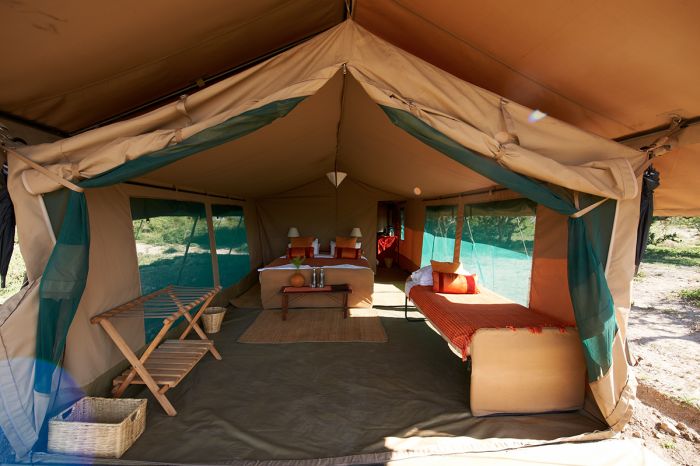
Guest tent at Ubuntu Migration Camp.
Accommodation
10 guest accommodations in total comprising:
- 9 classic, Meru-style, canvas safari tents, 7 of which can be set up with a double or twin beds, and 2 of which can be a triple to accommodate a child under the age of 16 years.
- 1 double / family tent consisting of two bedrooms, one with a double bed (convertible to twins) and one with two single beds. The bedrooms each have their own en-suite facilities. There is a shared indoor lounge between the bedroom.
The tented rooms are all canvas and constructed on the ground with a small covered seating area at the front entrance.
Every tent includes en-suite facilities (not plumbed) with a double-basin vanity, indoor bucket shower (hot water provided on request), and flush toilet. The tents are accessed via footpaths on the ground leading to the main camp area.
The camp and tents are spread out amongst an open woodland with views onto the Serengeti grasslands.
Other items and features in the guest tents include:
- Luggage rack.
- Mosquito netting over the beds.
- Safe.
- 24-hour power (provided using a combination of solar and generator) for lighting and charging electronics.
- Hairdryers are not supported by the solar / generator power system.
- WiFi available in the guest tents and main guest areas.
- Mobile phone signal available, but limited.
Ubuntu Camp can accommodate a maximum of 24 guests in total: 2 persons in each of the 9 standard tents (plus one additional child in two tents), and 4 persons in the family tent.
Includes & Excludes
Includes:
- All meals and house drinks, including wines, local brand spirits and beers, teas, and coffees.
- Safari experiences (twice-daily or full-day game drives, bush walks in the northern location only, and birding) accompanied by an experienced guide.
- Sundowner drinks and snacks.
- Laundry services are provided on a daily basis (weather permitting, items will be returned on the same day). Laundry is dried by the sun and on most days any laundry placed out in the morning will be returned by the evening.
- Wi-Fi access (throughout the entire camp).
- Airstrip transfers (Kogatende Airstrip in the north and Kusini Airstrip in the south).
- Tourism Levy & VAT.
Excludes:
- Champagne, cognacs, fine wines, premium brand spirits, and cigars.
- Hot-air ballooning (southern location only).
- Cultural community visits (northern location only).
- Purchases from the Gift Shop.
- Any applicable wildlife fee, park fee, reserve fee, concession fee, other land-use fee.
Single Supplement
A single supplement may apply for any room booked by a single traveler; please ask us for pricing.
Children
Children aged 5 years and older are accommodated at Ubuntu Migration Camp:
- 1 family tent and 1 standard tent available as a triple.
- Ask us about reduced rates for children sharing with adults or children 12-17 in their own tent.
- The minimum age for children on bush walks is 12 years and at the discretion of the guide.
- Children's menu available.
- Children under 5 years are allowed only if the camp is booked exclusively.
Game drives with children:
- During high and peak seasons, families (less than 5 persons) with children aged 0-12 years must pre-book a private vehicle.
- During low and peak seasons, families (less than 5 persons) with children aged 0-12 years will receive a private vehicle FOC subject to availability. Vehicle must be pre-booked.
- Year-round, families with children aged 0-12 years will receive a private vehicle FOC for every 5 persons in the family. This is subject to vehicle availability and must be booked in advance.
Facilities
In both the north and south locations, the camp and tents are located in a semi-open area with scattered trees and views onto the Serengeti plains.
The main guest area consists of a two open-plan tented areas on the ground comprising a dining room, lounge, and bar. Roll-down canvas flaps on all sides are generally left open unless there is wind or rain. The area in front of the tented spaces includes a campfire and outdoor dining area.
Main guest area facilities include:
- The main guest area comprises two open-plan tented spaces that include a dining area, lounge, and bar.
- Dining is typically communal, but private dining is available on request.
- Campfire area.
- Gift Shop.
- Complimentary Wi-Fi access.
- Mineral water is provided in the main camp areas and in the guest tents.
- The camp is powered by a combination of solar and generator.
Activities
Activities included in the rate:
- Morning and afternoon/evening game drives in semi-open 4x4 vehicles.
- Guided bush walks (only available in the northern location).
- Bush meals and sundowners.
- Birding.
- Child-friendly activities.
- All game drive vehicles fitted with inverters for battery charging on game drives.
Optional activities at additional cost:
- Private activities are on offer (subject to vehicle availability, which needs to be booked in advance).
- Use of the customized Asilia photographic game drive vehicle. This is only available in the northern location. The vehicle is based at Sayari Camp, but also bookable from Olakira and Ubuntu. Maximum three photographers. Best to reserve in advance.
- Hot-air ballooning (only available in the southern location; may be booked in advance).
- Guided visit to a local Kuria tribe community (only available in the northern location).
Example of a typical day:
- Early morning wake-up call. Morning wake-up and activity times vary according to the seasons, activities on offer, and wildlife sightings.
- Light breakfast before departing on the morning activity or food packed for an earlier departure.
- Return to the camp for a meal and rest period (full-day outings mean lunch is packed).
- Meet for afternoon tea and snacks (savory and sweet choices) before departing on the activity.
- Return to camp - freshen up or meet for drinks, followed by dinner.
- Enjoy a nightcap and/or discussion at the bar or around the campfire before retiring.
Great Good Fair Poor
- Jan
- Feb
- Mar
- Apr
- May
- Jun
- Jul
- Aug
- Sep
- Oct
- Nov
- Dec
General Tips
It is advised to avoid the Serengeti over March and April, when heavy rains typically occur. June to mid-October is excellent for general game viewing. The large herds of animals in the Great Migration usually cross into the Serengeti from Kenya's Masai Mara sometime around early October and move north back into Kenya around mid- to late-July.
Besides the Great Migration, the other big factor that impacts a stay in the Serengeti is rains. The region experiences most of its rain between November and May, but there are two somewhat distinct rain seasons, the 'short' rains and the 'long' rains (read more below).
Ubuntu Migration Camp is open 15-June thru 14-November and 15-December thru 14-March. See the Details tab for the applicable dates at each location.
Rains
Short Rains
The short rains occur for about one month sometime during November and December (the exact time varied somewhat year to year). This period is called the 'short' rains because the duration of an individual rain event is short and it is rare to have an all-day rain event. Most rain falls as an afternoon shower, while mornings are typically overcast or clear.
Long Rains
The long rains occur between March and May, with April being the wettest month of the year. During this tome, rain should be expected almost every day and the showers can last for hours at a time, although all-day rain is not typical. The roads in the Serengeti become muddy and very difficult in places, which can hamper game drives. Cloudy skies are typical and temperatures can be chilly at times.
The period between the short and long rains (January and February) also receives rain, but many days are clear and the amount and duration of the rain events is unpredictable, with some afternoon showers and the odd long and heavy rainfall event.
Temperatures
The temperatures in the Greater Serengeti do not experience wide fluctuation throughout the year, as the region lies between one and three degrees south of the equator. In general, daytime temperatures are comfortably warm and overnights and early mornings are chilly. Bring a fleece and rain jacket regardless of the timing of your visit.
Dry Season
The dry season (June to October) is sunny and warm most days and rarely hot. Rare rain showers can occur but are unlikely. From June thru August, the afternoon temperature averages 76-78°F (24-25°C), but some days can be warmer. Evenings and early mornings temperatures are often chilly, averaging 53-55°F (12-13°C).
September and October days are very pleasant, with temperatures averaging 80-83°F (28-30°C), with cool mornings persisting, averaging 53-56°F (11-13°C).
Rainy Season
The rain season is November through May (read more above) and the temperatures are fairly static throughout the season. Daytime temperatures average 79-83°F (26-28°C) and nighttime and early morning temperatures are chilly, but slightly warmer than the dry season, averaging 54-57°F (12-14°C)
The Great Migration
The annual movement of wildebeest and zebras across the Serengeti-Mara ecosystem is one of the greatest spectacles in the natural world. These large herds move in a circular track across southern Kenya and northern Tanzania, taking a full year to complete their cycle. The migration moves across both the Greater Masai Mara (in Kenya) and the Greater Serengeti (in Tanzania) in a fairly consistent pattern and timeframe. The animals move to take advantage of fresh grasses on which to graze.
The migrating herds of roughly 1.5 million blue wildebeests and several hundred thousand plains zebras spend about nine months of the year moving through Tanzania's Greater Serengeti and the other three months in Kenya's Greater Masai Mara. The migrating herds are in Tanzania's Greater Serengeti from sometime in October until around late-July (note that the timing is never precise and varies somewhat year to year). Note that the Serengeti is vast, and it is important to note where in the region the herds are located during this nine-month timeframe.
The animals spread out to cover a vast area, but the main bulk of the animals moves south into the northern Serengeti around late-October and continue moving south towards the Serengeti's southern plains, arriving there sometime in January to graze on the rich grass growing on the volcanic soils. It is here on these short-grass plains, between January and early March, when the wildebeests give birth to their young en masse, producing some 500 000 baby wildebeests.
The herds remain on the southern short-grass plains until late March, giving the young animals time to grow and become strong, before heading north and west again. Many of the animals move towards the Serengeti's Western Corridor and Grumeti Reserve and the rest straight north into Central and Northern Serengeti, where they remain during June and into July. The herds move back into Kenya starting in late July, with the bulk moving into the Masai Mara in August.
The migration is rarely ever the same in terms of precise timing and direction, as local rains and other conditions influence grass growth. The wildebeest may, therefore, move off the open plains earlier in some years and remain in the northern Serengeti for longer in others. Nonetheless, the best months for seeing the migration in the Southern Serengeti are in February and March, when the herds are adding new babies, in the Central Serengeti during May and June, when the herds are the most concentrated, and in the Western Corridor, Grumeti, and far Northern Serengeti from June thru August.
Many visitors hope to witness dramatic river crossings, when hungry crocodiles attack the herds as they swim across the dangerous rivers of the Northern Serengeti. Like the migration in general, the precise timing of the river crossings is never known from year to year, but crossings on the Grumeti River are usually best in June, while Mara River crossings are best in July and August.




